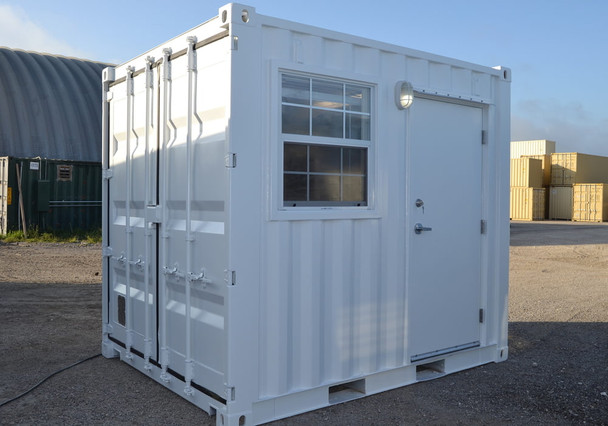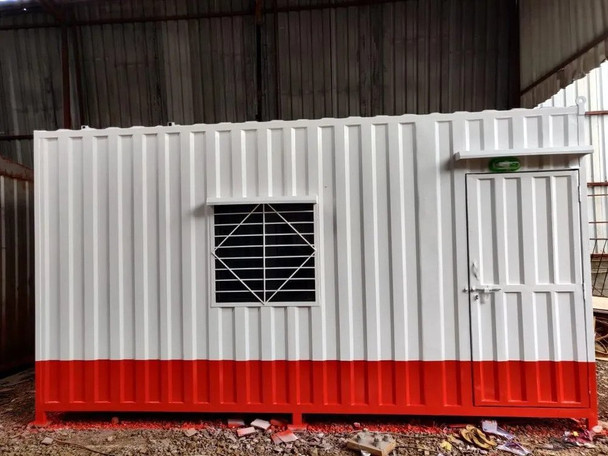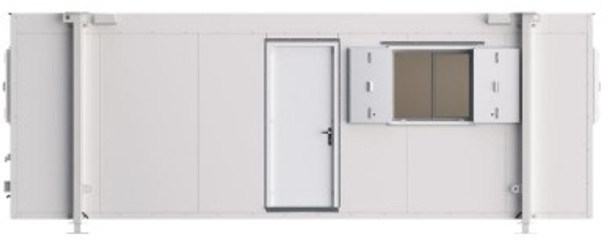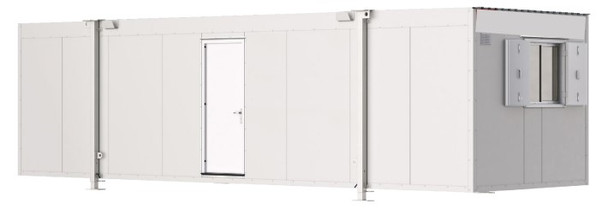How Portacabin and Shelter Containers Can Help Your Business Adapt to Changing Needs
Portacabins, also known as portable cabins, modular buildings or offshore containers, are prefabricated structures that can be easily transported and assembled at various locations. Portacabins are designed to provide temporary or permanent shelter and can serve a wide range of purposes, from office spaces and classrooms to accommodation units and storage facilities. Shelter containers, on the other hand, are modified shipping containers that have been repurposed for use as temporary or permanent structures. These containers offer durability, security, and mobility, making them ideal for a variety of applications, including construction sites, disaster relief efforts, and remote work environments.
One innovative solution that businesses are turning to is the use of sustainable portacabins and shelter containers. These versatile structures offer a range of benefits, allowing businesses to swiftly adapt to changing needs while maintaining efficiency and productivity. Both portacabins and shelter containers come in a variety of sizes and configurations to suit different needs. They can be customized with features such as windows, doors, insulation, lighting, and HVAC systems to create comfortable and functional spaces. Additionally, these structures can be interconnected or stacked to create larger complexes or multi-level facilities, providing scalability and flexibility.
Stay tuned for the next sections where we delve deeper into the benefits of portacabins and shelter containers, their applications across industries, and tips for choosing the right solution for your business.

Portacabin and Shelter containers for Site office 8 ft long - Experience unmatched durability and design with our Shelter containers.
Benefits of Portacabins and Shelter Containers
Portacabins and shelter containers offer a myriad of advantages that make them indispensable assets for businesses across various sectors. Some of the key benefits they bring to the table are:
1. Flexibility in Deployment
Portacabins and shelter containers offer unparalleled flexibility, making them an ideal choice for businesses that require adaptable solutions. Their modular design allows for easy assembly and disassembly, enabling companies to respond swiftly to market demands, seasonal changes, or unexpected events. Whether it’s expanding office space, setting up temporary housing, or creating pop-up retail outlets, these structures can be deployed quickly to various locations, ensuring business continuity and agility. Additionally, these units can be quickly expanded or downsized as needed, providing a scalable solution that aligns with evolving business demands.
2. Cost-Effectiveness
One of the most compelling advantages of portacabins and shelter containers is their cost-effectiveness compared to traditional construction methods. The upfront cost of purchasing or leasing these modular units is significantly lower than constructing permanent buildings, thereby offering substantial savings for businesses, especially those operating on tight budgets or in rapidly changing environments.
Moreover, the operational costs associated with portacabins and shelter containers are generally lower due to their energy-efficient designs. These units can be equipped with sustainable features such as solar panels, LED lighting, and efficient insulation, further reducing utility expenses over time. Additionally, the versatility of these modular structures allows businesses to repurpose them for different applications, maximizing their return on investment.
3. Rapid Setup and Relocation
Time is of the essence in today's fast-paced business landscape, and portacabins and shelter containers excel in delivering rapid setup and relocation capabilities. Unlike traditional construction projects that can take months or even years to complete, these modular units can be installed and made operational within a fraction of the time.
The prefabricated nature of portacabins and shelter containers allows for quick assembly on-site, minimizing downtime and ensuring business continuity. Whether it's an urgent need for additional workspace or emergency relief efforts in disaster-stricken areas, these modular units can be swiftly deployed to address critical needs.
Portacabin and Shelter Containers - Spacious 15 ft containers for dynamic site offices and productive meeting rooms.
Applications of Offshore containers across Industries
Offshore containers, renowned for their durability and versatility, find a wide array of applications across diverse industries. Let's explore how these robust containers cater to the specific needs of various sectors:
Construction and Infrastructure Projects
Offshore containers are a cornerstone in the construction and infrastructure sectors, providing robust and secure storage solutions on-site. They are used to house tools, machinery, and materials, protecting them from the elements and potential theft. Their standardized dimensions ensure easy stacking and handling, which is crucial in the dynamic environment of construction sites. Moreover, these containers can be converted into mobile command centers, facilitating on-the-ground project management and coordination.
Temporary Offices and Workspaces
The versatility of offshore containers extends to their conversion into temporary offices and workspaces. This application is particularly useful for industries that operate in remote locations, such as mining, oil and gas exploration, and large-scale agriculture. These portable units can be outfitted with insulation, electricity, and HVAC systems, providing comfortable and functional spaces for staff, even in harsh environments. Their mobility allows businesses to quickly deploy office facilities wherever needed, whether it's for short-term projects, expansion initiatives, or disaster recovery efforts. Furthermore, offshore containers offer businesses the flexibility to scale operations according to fluctuating demands. As workforce needs evolve, these modular units can be easily reconfigured, expanded, or relocated to align with changing business priorities, ensuring maximum efficiency and adaptability.
Disaster Relief and Emergency Response
In times of crisis, rapid mobilization and effective resource management are paramount for disaster relief and emergency response efforts. Offshore containers serve as indispensable assets in facilitating swift, organized, and efficient relief operations, providing essential infrastructure, supplies, and support services in disaster-stricken areas.
These robust containers are utilized as mobile command centers, medical clinics, shelters, and storage facilities, enabling relief organizations to establish operational bases and deliver critical aid to affected communities promptly. Their rugged construction and weather-resistant properties ensure the safety and security of personnel and supplies, even in the most challenging conditions. Moreover, offshore containers are instrumental in facilitating rapid deployment of emergency response teams and equipment to disaster zones, helping mitigate the impact of natural disasters, humanitarian crises, and other emergencies.
Portacabin and Shelter Containers - 20ft of smart design, delivering exceptional on-site office experiences.
Tips for Choosing the Right Portacabin and shelter container
Selecting the appropriate portacabin or shelter container is crucial for ensuring that your business needs are met effectively. Here are some essential tips to guide you through the decision-making process:
Assessing Business Needs and Requirements
Before investing in a portacabin or shelter container, it's essential to conduct a thorough assessment of your business needs and requirements. Consider factors such as:
- Space Requirements: Determine the intended use of the container and assess the space needed to accommodate your operations comfortably. Whether it's for office space, storage, accommodation, or specialized functions, understanding your spatial requirements is critical for selecting the right size and configuration.
- Location and Environment: Evaluate the environmental conditions and location where the container will be deployed. Factors such as climate, terrain, accessibility, and local regulations can influence your choice of container type, construction materials, and additional features required for optimal performance and durability.
- Functional Specifications: Identify specific features and functionalities essential for your business operations. Whether it's built-in amenities, such as HVAC systems, lighting, insulation, or specialized equipment and infrastructure, aligning container specifications with your operational needs is key to maximizing efficiency and productivity.
- Budget Constraints: Establish a clear budget and cost parameters for acquiring and deploying the container. Consider not only the initial purchase or lease costs but also ongoing maintenance, transportation, and customization expenses to ensure that the investment remains within budgetary constraints.
See Also: How Portable storage Containers Help Reduce Carbon Emissions on Construction Sites
Evaluating Available Options and Customization
Once you've identified your business needs, it's time to evaluate the available options and explore customization possibilities to tailor the container to your specific requirements. Consider the following factors:
- Container Types and Configurations: Assess the various types of porta cabins and shelter containers available in the market, such as standard shipping containers, modular units, or specialized designs. Evaluate their sizes, layouts, and structural specifications to determine which option best aligns with your space and functional requirements.
- Quality and Durability: Prioritize containers manufactured from high-quality materials and built to withstand the rigors of transportation, installation, and long-term use. Inspect the structural integrity, corrosion resistance, and weatherproofing features to ensure that the container can withstand environmental challenges and maintain performance over time.
- Customization Options: Explore customization options offered by container suppliers to tailor the unit to your specific needs and preferences. Whether it's interior layout modifications, installation of additional features, or branding and aesthetic enhancements, partnering with suppliers who offer customization services can help optimize the container's functionality and visual appeal.
Need a spacious and secure headquarters for your next project? Portacabin and Shelter Containers 40ft Long Site Offices - perfect for construction sites, temporary housing, or remote workspaces.
Future Trends and Innovations
As industries evolve and technology progresses, the landscape of portacabins, shelter containers, and modular construction continues to witness significant advancements. Here are some key future trends and innovations to keep an eye on:
Advancements in Portacabin and Shelter Container Technology
- Smart Integration: Future portacabins and shelter containers are likely to incorporate smart technologies for enhanced functionality and efficiency. This may include IoT (Internet of Things) sensors for monitoring environmental conditions, energy usage, and security, allowing for remote management and optimization of resources.
- Sustainable Solutions: With increasing emphasis on sustainability and environmental responsibility, future containers are expected to feature eco-friendly materials, energy-efficient designs, and renewable energy sources such as solar panels and wind turbines. Additionally, innovations in waste management and water conservation within container structures are likely to become more prevalent.
- Modular Flexibility: Advancements in modular design and construction techniques will enable greater flexibility and customization options for portacabins and shelter containers. Modular components may become more standardized yet adaptable, allowing for easy integration, expanson, and reconfiguration to meet evolving needs and preferences.
- Advanced Materials and Construction Techniques: Future containers may benefit from advancements in materials science and construction technologies, resulting in lighter yet stronger structures with improved durability, insulation, and weather resistance. Innovative materials such as graphene, aerogels, and advanced composites may revolutionize the design and performance of container units.
- Off-Grid Capabilities: As off-grid and remote operations become more prevalent across various industries, future portacabins and shelter containers are likely to offer enhanced off-grid capabilities, including self-sustaining power generation, water purification systems, and waste recycling technologies. This will enable businesses to operate autonomously in remote locations without relying on external infrastructure.
Emerging Trends in Modular Construction
- Vertical Integration: Future trends in modular construction may involve greater vertical integration, where entire buildings or structures are assembled off-site in modular units and then stacked or assembled on-site like building blocks. This approach allows for faster construction times, reduced labor costs, and increased quality control compared to traditional construction methods.
- Prefabricated Skyscrapers: As urbanization continues to grow, there is a rising interest in prefabricated skyscrapers and high-rise buildings constructed using modular components. This innovative approach to vertical construction offers rapid scalability, sustainable practices, and cost efficiencies while addressing the challenges of urban density and housing shortages.
- 3D Printing Technology: 3D printing technology is poised to revolutionize modular construction by enabling the rapid prototyping and manufacturing of complex structural components and building modules. This additive manufacturing process offers greater design freedom, material efficiency, and customization options, paving the way for more creative and sustainable construction solutions.
- Robotics and Automation: The integration of robotics and automation into modular construction processes will streamline manufacturing, assembly, and installation operations, reducing reliance on manual labor and improving efficiency, precision, and safety. Automated fabrication facilities and robotic assembly lines will enable mass production of modular components with minimal human intervention.
- Flexible and Adaptable Designs: Future modular construction projects will prioritize flexibility and adaptability, allowing buildings to evolve and respond to changing needs and functions over time. Modular components designed for disassembly, reuse, and reconfiguration will enable buildings to be easily modified, expanded, or repurposed without the need for extensive demolition or reconstruction.
Related Article;
Why Choosing the Right Size Portacabin and Shelter Container is Important for Your Project
The Different Types of Portacabin and Shelter Containers and Their Uses
Conclusion
In an ever-evolving business landscape, portacabins and shelter containers stand out as versatile, cost-effective, and innovative solutions that can help businesses adapt to changing needs with agility. From construction sites to disaster-stricken areas, these modular marvels offer flexibility in deployment, rapid setup, and relocation capabilities that traditional structures simply cannot match. As we look to the future, the advancements in technology and emerging trends in modular construction promise even more exciting possibilities, paving the way for smarter, more sustainable, and adaptable business practices.
By embracing the benefits and applications of portacabins and shelter containers, businesses can not only overcome spatial and logistical challenges but also position themselves at the forefront of industry innovation. Whether it’s through leveraging cutting-edge technology or staying ahead of construction trends, the potential of these dynamic structures is boundless. As we continue to witness their transformative impact across industries, one thing is clear: portacabins and shelter containers are more than just a temporary fix, they are a strategic asset for any forward-thinking enterprise. For more information or assistance.. Contact Us Today.
Recent Posts
-
Press Release: Same Great Lube, Less Waste: Lubemax 50:50 makes the Switch to Sustainable Packaging
In a move towards environmental responsibility, Epoxy Oilserv Nigeria Limited is proud to announce t …Apr 23, 2024 -
Top 8 Generators Recommended by Professionals in Nigeria (Reviews)
Generators can keep your home or business running with your essential equipment until the power is b …Apr 23, 2024 -
Transformer Safety: Preventing and Managing Common Hazards
Transformers are critical components in the electrical distribution system, handling high volt …Apr 23, 2024






